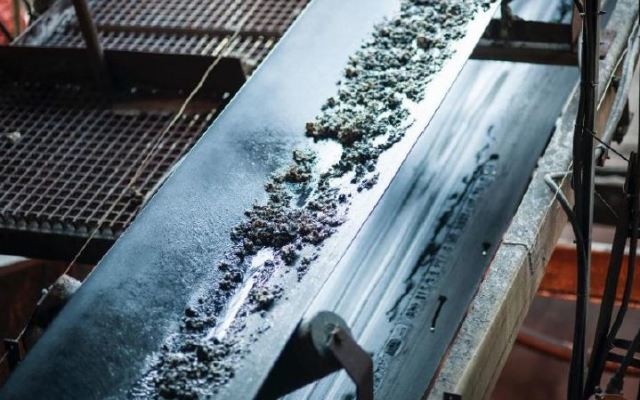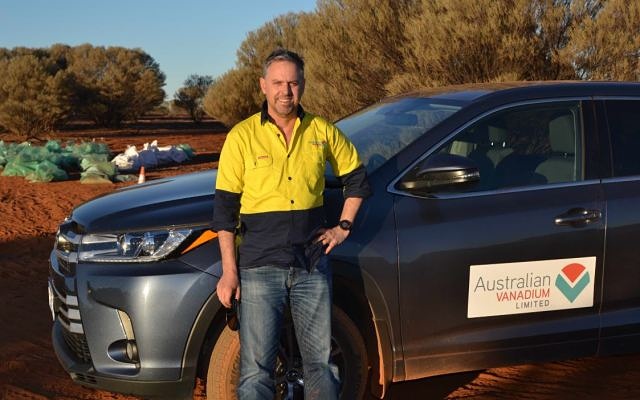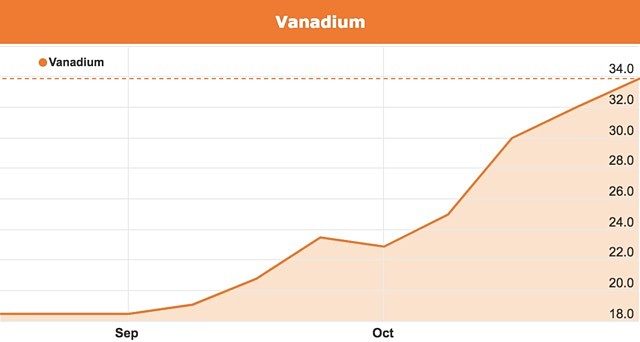China’s new vanadium-steel rebar standards take effect, what’s next for vanadium market?

China’s new standards requiring more vanadium in its steel come into effect tomorrow.
As China’s November deadline to incorporate more vanadium in its steel rebar takes effect tomorrow, vanadium investors are left wondering the impact this will have on the commodity, which is already experiencing a tight market that has driven its price up more than 840% in the last two years.
China’s Standardization Administration announced the new high strength rebar standard back in February this year, saying it would officially come into effect on 1 November 2018.
Under the new standard, 0.03% vanadium will be incorporated in grade three steel, with this amount increasing with each grade to require more than 0.1% in grade five rebar.
Vanadium organisation Vanitec’s John Hilbert said the new standard is a “positive development” towards boosting vanadium consumption world-wide.
“Vanadium is the most common addition for high strength rebar, because it offers the best combination of high strength, good ductility, bendability, weldability and reduced sensitivity to strain aging,” Mr Hilbert explained.
Additionally, when incorporated in the steel rebar, vanadium can be used in economical hot rolling practices.
Market dynamics
Commenting on the current vanadium market, Australian Vanadium (ASX: AVL) managing director and Vanitec committee member Vincent Algar said it was an “exciting” time for the sector.
After languishing between 2010 and 2017, the commodity has seen a resurgence due to the strengthening steel industry and vanadium’s emerging use in the vanadium redox flow battery.
Additionally, one lesser known fact about vanadium is it outperformed other battery metals in 2017 – outdoing the likes of cobalt, lithium and nickel, according to Bloomberg.
This rapid vanadium growth is expected to continue, propelled by China’s new steel rebar standards and the fact that many Chinese-based steel manufacturers are believed to be short of vanadium.
“I can see that there’s a very large demand and very large market for new vanadium production,” Mr Algar noted.
He added Australian Vanadium hoped to be able to deliver into that market with its advanced flagship Gabanintha project in Western Australia.
Price performance
According to Mr Algar, the vanadium price is now “hitting its high-level straps”.
A commonly traded vanadium product is 98% pure vanadium pentoxide. Since the start of 2017, the price for this product has risen from around US$3.50 per pound to its current value of more than US$33/lb – equating to a hike of more than 800%.
Many investors believe the price will max out soon because it has pushed past its previous high of around US$25/lb in 2005-2006, but Mr Algar says the present market conditions are “completely different” to previous times.
Ferrovanadium, which is another traded vanadium product has grown from an average of US$33 per kilogram in 2017 to push past US$100/kg in September.
Mr Algar pointed out people are debating whether vanadium has reached its peak, or if there has been a “step change” in the market.
“This new position has not been reached before in such a way,” he said.
“It spiked the last time it was here, and this is not a spike.”
“This is a slow and steady increase from an all-time low where we had a supply shock to the market,” he explained.
Analysts such as Roskill are predicting vanadium consumption will reach around 133,000 tonnes per annum by 2025 and this estimate doesn’t take into account the mounting demand for the commodity in redox flow batteries.
In 2017, about 90% of vanadium was swallowed up by the steel industry, with the redox flow battery market accounting for a mere 2% of vanadium production.
However, vanadium consumption in redox flow batteries is predicted to soar to 20% of global production by 2030 as the sustainable energy revolution surges ahead.
ASX-listed vanadium companies are looking to fill this demand, including Australian Vanadium (ASX: AVL), Tando Resources (ASX: TNO) and recently-listed QEM Ltd (ASX: QEM), to name a few.
Stone coal supply shock
Previously when the vanadium price fell, a supply shock came from China where an influx of vanadium flowed onto the market from stone coal processing, which generates vanadium as a by-product.
However, Mr Algar pointed out the Chinese Government’s tightened environmental regulations would prevent this from occurring again.
“In order to get the vanadium out of the stone coal, you have to leach it, roast it, then leach it with acid.”
“It’s a very dirty process that’s done by various small corporations throughout China. It’s extremely environmentally damaging. It introduces toxins and acid into the environment.”
“It’s outlawed by the Chinese authorities and they have been very clear … it is a matter of record that they will not accept that environmental degradation under any circumstances.
“No market conditions will allow corporations in China to pollute both the air and the land,” Mr Algar explained.
Additionally, other major vanadium producing countries such as Russia have closed environmentally dubious operations and enforced more stringent regulations on the industry.
Projected supply and consumption
With tighter environmental regulations, new rebar steel standards, lack of imminent vanadium supply in the pipeline, and a booming steel sector, Mr Algar pointed out vanadium consumption would continue to grow creating even more constricted market conditions.
When commenting on the commodity’s price movement, Mr Algar said he expected the vanadium price will taper off at some stage in the future, but the current deficiency in replacement supply, combined with increased demand would drive price higher in the near-term.

The outlook for vanadium demand remains strong.
Many investors are betting on how high it will go with some predicting the 98% vanadium pentoxide price will push past US$40/lb.
Adding to the situation is the prediction new vanadium supply will not come online until at least 2022.
And, until then, it’s estimated about two new operations the size of London AIM-listed Bushveld Minerals’ Vametco asset are required to come online each year for the next seven years just to meet projected market consumption.
Major producers
More than 90% of the world’s vanadium arises out of South Africa, China and Russia.
Meanwhile, China is the largest vanadium consumer globally, with the nation scooping up more than 40% of world-wide production in 2017. This is expected to grow further on the back of nation’s new rebar standards.
There are only a handful of major vanadium producers globally, which, even if these producers expanded their operations, it would only equate to one new-mine worth of production, according to Mr Algar.
TSX-listed Largo operates the Maracas Menchen vanadium mine in Brazil. The open pit mine is expected to produce up to 10,150t of vanadium in the 2018 calendar year.
Bushveld Minerals is another major vanadium producer as well as Glencore, with both operating mines in South Africa.
Through its Bushveld Vanadium subsidiary, Bushveld Minerals has a controlling interest across three assets with combined JORC reserves of 55Mt vanadium. Bushveld’s Vametco mine’s nameplate capacity recently expanded to 3,750tpa vanadium after producing 2,649t vanadium in 2017.
Another major vanadium play is Swiss-based and LSE-listed Glencore, which produced 20.9 million pounds of vanadium pentoxide in 2017. The company operates the Rhovan open-pit vanadium mine and smelter complex near Brits in South Africa.
The operation produces ferrovanadium and vanadium pentoxide.
Additionally, Glencore controls the sale of Largo’s production with an existing agreement to purchase 100% of all Largo vanadium.
Since the start of 2018, Largo’s share price has followed the vanadium price rise, with the company’s stock price lifting off C$1.35 in January to hit C$4.23 towards the end of October – a whopping 213% gain.
Similarly, Bushveld Minerals’ share price has increased more than 280% from £0.0813 since the start of the year to touch £0.31 in late September and still trading around that price today.
With its broader exposure to multiple commodities, Glencore’s share price hasn’t been as lucky.
“High prices have contributed to a flurry of new announcements regarding projects, both in China and elsewhere. While a few projects are relatively advanced in their development, most are years away from producing and face the numerous obstacles associated with project development,” Roskill predicts.
Mr Algar said getting a vanadium operation off the ground requires substantial capital expenditure and this may deter potential investors.
He added many investors are still on the sidelines taking bets on which vanadium junior will eventually get its project over the finish line, particularly when the vanadium price eventually tapers off.
Australian Vanadium
Mr Algar said Australian Vanadium was seeking to bring its operating costs at Gabanintha to the lowest possible number to ensure a long-term, commercially viable vanadium operation – especially during the bottom of a cycle.
“The lowest cost producers of vanadium around the world will have a hybrid concentrate, a low operating cost, and a very high mass yield. We feel we fit comfortably in that space,” Mr Algar said.

Australian Vanadium managing director Vincent Algar is focussed on advancing the company’s flagship Gabanintha vanadium project.
“We think the vanadium price will never go below US$5/lb or US$6/lb. That means we are targeting our operating cost around the US$4/lb mark.”
Mr Algar pointed out that even if the vanadium price plunged from its current price of more than US$33/lb to US$15/lb, it would still generate “very healthy” margins for Australian Vanadium.
“We see the market remaining strong for some time. Maybe not at these prices. But, if the price has been reset, maybe the low is more like US$10/lb to US$15/lb rather than US$5/lb to US$8/lb, which is what it was before,” Mr Algar added.

